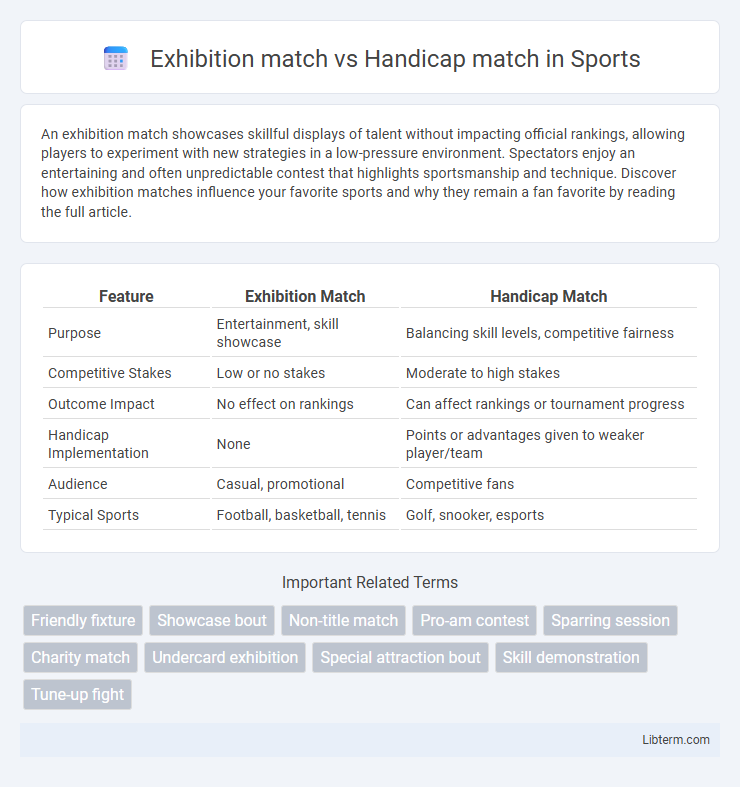An exhibition match showcases skillful displays of talent without impacting official rankings, allowing players to experiment with new strategies in a low-pressure environment. Spectators enjoy an entertaining and often unpredictable contest that highlights sportsmanship and technique. Discover how exhibition matches influence your favorite sports and why they remain a fan favorite by reading the full article.
Table of Comparison
| Feature | Exhibition Match | Handicap Match |
|---|---|---|
| Purpose | Entertainment, skill showcase | Balancing skill levels, competitive fairness |
| Competitive Stakes | Low or no stakes | Moderate to high stakes |
| Outcome Impact | No effect on rankings | Can affect rankings or tournament progress |
| Handicap Implementation | None | Points or advantages given to weaker player/team |
| Audience | Casual, promotional | Competitive fans |
| Typical Sports | Football, basketball, tennis | Golf, snooker, esports |
Understanding Exhibition Matches: Definition and Purpose
Exhibition matches are non-competitive games organized primarily for entertainment, player practice, or charity, without affecting official rankings or records. These matches provide players an opportunity to test strategies and build form in a low-pressure environment. Unlike handicap matches that balance skill disparities by assigning advantages, exhibition matches focus on showcasing skills without altering competitive fairness.
What is a Handicap Match in Sports?
A handicap match in sports is designed to level the playing field by giving a virtual advantage or disadvantage to competitors based on their skill levels, ensuring more balanced and competitive outcomes. This adjustment can be applied in various sports like golf, tennis, and wrestling, where one player or team starts with a score or advantage that compensates for differences in ability. Unlike exhibition matches, which are primarily for entertainment or practice without affecting rankings, handicap matches aim to create fair competition through calculated scoring modifications.
Key Differences Between Exhibition and Handicap Matches
Exhibition matches are non-competitive games primarily meant for entertainment, practice, or charity, often without official rankings or stakes involved. Handicap matches assign a specific advantage or disadvantage to players based on skill level to create a balanced competition, frequently used in golf or chess. Key differences include the purpose--exhibition for showcasing talent, handicap for leveling playing fields--and the impact on official records, with exhibition matches typically not affecting rankings.
Rules and Regulations: Exhibition vs Handicap Matches
Exhibition matches feature flexible rules designed primarily for entertainment, often allowing experimental formats and relaxed officiating to prioritize player engagement and audience enjoyment. Handicap matches impose specific rules to balance skill disparities, granting advantages such as point leads or reduced challenges to the underdog, thereby ensuring fair competition. Both match types follow standardized regulations within their categories, with exhibition matches emphasizing exhibition guidelines and handicap matches adhering to official handicap scoring systems to maintain competitive integrity.
Common Sports Featuring Exhibition and Handicap Formats
Exhibition matches and handicap matches are popular in sports like golf, tennis, and boxing, where exhibition matches often serve as non-competitive showcases highlighting skill and entertainment without official ranking implications. Handicap matches are designed to level the playing field by adjusting the scoring or starting conditions based on players' abilities, common in golf and horse racing to balance competition. Both formats enhance spectator engagement by either showcasing elite talent without pressure or creating more competitive and unpredictable outcomes.
Strategic Approaches in Exhibition and Handicap Matches
Strategic approaches in exhibition matches prioritize experimentation and player development, allowing teams to test formations and tactics without pressure on official standings. In contrast, handicap matches demand adaptive strategies that balance skill disparities, often involving tactical concessions or aggressive plays to overcome the imposed limitations. Effective management of player roles and dynamic in-game adjustments are crucial for success in both formats.
Athlete Preparation: Exhibition vs Handicap Scenarios
Exhibition matches allow athletes to focus on performance refinement and skill showcase without competitive pressure, fostering confidence and technical adjustments. In handicap matches, athletes must prepare strategically to overcome disparities, emphasizing adaptability and resilience to offset disadvantages. Training for exhibition scenarios often targets specific skill enhancement, while handicap preparation demands comprehensive conditioning and mental toughness to compete effectively.
Audience Engagement: Which Match Type Attracts More Fans?
Exhibition matches often attract more casual fans by showcasing star players in a relaxed, entertaining environment that emphasizes spectacle over competition. Handicap matches, designed to balance skill disparities for thrilling unpredictability, captivate dedicated audiences seeking intense, strategic gameplay. While exhibition matches draw larger crowds through celebrity appeal, handicap matches engage hardcore fans craving competitive balance and dynamic matchups.
Notable Examples of Exhibition and Handicap Matches
Notable exhibition matches include the 1976 Muhammad Ali vs. Antonio Inoki bout, which blurred the lines between boxing and wrestling, drawing global attention without official rankings. In contrast, handicap matches, such as the 1997 WWE match where The Undertaker faced multiple opponents simultaneously, highlight uneven team dynamics designed to showcase individual dominance. Both formats emphasize entertainment and storytelling over competitive balance, with exhibition bouts often serving charitable causes and handicap matches emphasizing dramatic tension.
The Future of Exhibition and Handicap Matches in Sports
Exhibition matches maintain their popularity by offering players a controlled environment to showcase skills, experiment with strategies, and engage fans without the pressure of official rankings, contributing to their future as vital promotional tools in sports. Handicap matches continue evolving by promoting competitive balance and inclusivity, allowing athletes of differing skill levels to compete fairly, which enhances audience engagement and broadens participation. Innovations in digital technology and data analytics are expected to further refine match formats, increasing the entertainment value and strategic depth of both exhibition and handicap matches in the sports industry.
Exhibition match Infographic

 libterm.com
libterm.com